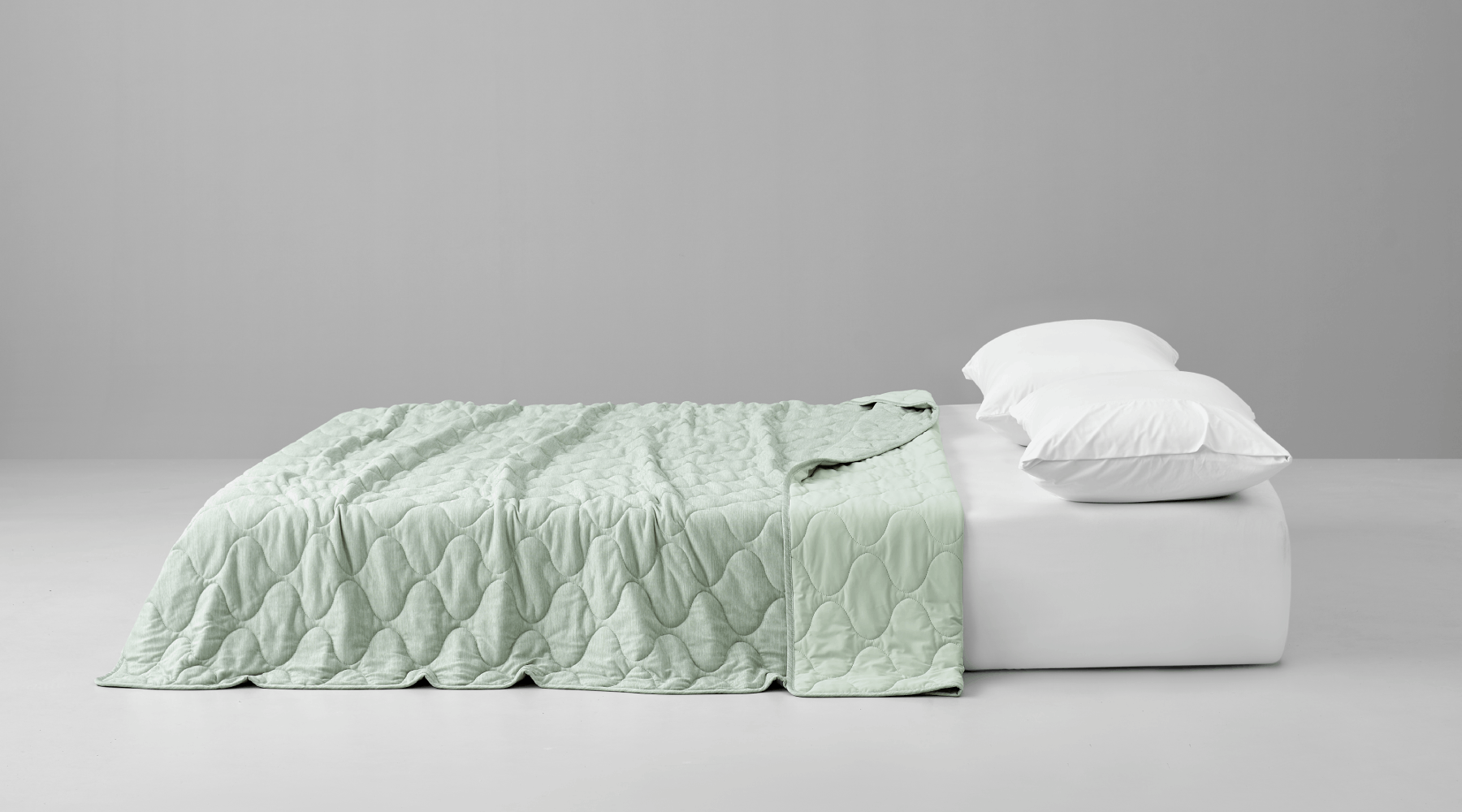On warm evenings, many people struggle to relax enough for sleeping. By helping control your temperature while you sleep, cooling comforters present a solution. Like any bedding, these specialty comforters need regular maintenance if they are to remain effective over time. This instruction will assist you to maintain the temperature-regulating qualities, extend the usable life, and take care of your cooling comforter.

1. Know Your Cooling Comforter's Composition
Before washing your cooling comforters, check what materials it's made from. Different comformter fabrics require different care methods to maintain their cooling properties.
- Bamboo: Breathable and moisture-wicking. Can shrink with high heat, so wash gently in cold water and dry on low heat.
- Tencel/Lyocell: Wood pulp-derived fabric that absorbs moisture well. Requires gentle washing and low-temperature drying.
- Eucalyptus: Similar to Tencel with good breathability. Often blended with other fibers - check the care label for specific instructions.
- Cooling Cotton: Uses special weaves (like percale) for better airflow. Follow care label recommendations for the specific treatment.
- Phase Change Materials: High-tech fabrics that regulate temperature. Avoid hot water and high heat when washing and drying.
- Polyester/Microfiber Blends: Durable and moisture-wicking but quality varies. Some are prone to pilling. Check care instructions.
- Silk: Naturally temperature-regulating but delicate. Usually requires dry cleaning or careful hand washing with special detergent.
The care label provides specific instructions for your comforter. It shows the recommended washing method, water temperature, drying method, and whether bleaching is permitted. When in doubt, follow these manufacturer guidelines to prevent damage.
2. Wash Your Cooling Comforter: A Step-by-Step Approach
Schedule Regular Cleanings
Laundering every two to three months under normal conditions helps most cooling comforters. Those with allergies, dogs sleeping on the bed, or people who have night sweats should think about more regular cleaning. Regardless of timetable, accidental spills need for quick response. Using a duvet cover creates a good barrier that greatly lessens the frequency of washing the blanket itself needs.
Spot-Treat Stains Before Washing
Before washing, check your comforter closely for any discoloration or patches. While avoiding strong chemicals that would undermine the cooling fibers, gently, fabric-appropriate stain remover should be applied to impacted regions. Let the treatment to take effect during the advised period before doing the complete wash.

Choose the Right-Sized Machine
Make sure your washing machine fits the comforter with enough of room; overcrowding prevents effective cleaning and increases fabric deterioration. As the drum turns, the comforter should move freely. Commercial-sized machines at laundromats provide a sensible option to home washing for large or bulky comforters.
Use Cold Water and Gentle Detergent
While hot water runs the danger of destroying specific fibers and reducing temperature-regulating qualities, cold or cool water maintains the integrity of cooling materials. Choose a gentle liquid detergent designed especially for sensitive fabrics. Conventional fabric softeners should be avoided since they leave residue that reduces moisture-wicking ability.
Select the Appropriate Cycle
The mild or delicate cycle reduces agitation, therefore preserving the structural integrity of the comforter and the specific cooling technology. While still efficiently eliminating dirt and oils from the fabric, this slower, less forceful washing technique reduces needless strain on the fibers.
Add an Extra Rinse Cycle
Finish the washing cycle with one more rinse cycle to remove any detergent left-over. This last stage guarantees best breathability and helps to avoid possible skin irritation caused by residual cleaning products. Complete elimination of detergent protects the capacity of the comforter to efficiently control temperature during sleep.
3. Drying Your Cooling Comforter
Air Dry When Possible
Air drying is the safest method for most cooling comforters. This approach protects the specialized cooling fibers from heat damage that can permanently reduce their effectiveness. Spread the comforter flat on a clean surface or hang it evenly across a clothesline in a well-ventilated area. Keep it away from direct sunlight to prevent color fading and material degradation. Gently shake and fluff the comforter every few hours to maintain even filling distribution and promote faster drying.
Use Machine Drying Carefully
If your comforter's care label permits machine drying, follow these specific guidelines to minimize potential damage. Select the lowest heat setting available on your dryer, as excessive heat is particularly harmful to cooling technologies. The "tumble dry low" option offers the gentlest mechanical action while still providing effective drying.
Add two or three clean dryer balls or new tennis balls to the load to prevent the filling from clumping together. These help maintain the comforter's loft and ensure even drying throughout. Monitor the drying process closely and remove the comforter when it's just barely dry—over-drying can damage delicate cooling fibers and reduce their temperature-regulating properties.
Ensure Complete Dryness
Before using or storing your comforter, verify it's completely dry throughout. Press firmly on different sections to detect any hidden moisture, paying special attention to seams and thicker areas where dampness tends to linger. Even slight residual moisture can lead to mildew growth and musty odors. If you detect any dampness, continue the drying process until the comforter is thoroughly dry.
4. Store Your Cooling Comforter When Not in Use
Clean and Dry Before Storing
When you're not using your cooling comforter, make sure it's completely clean and dry before putting it away. Even small amounts of dirt or moisture can lead to mildew, odors, and fabric deterioration during storage. If you're storing it for the season, a fresh wash and thorough drying will keep it in optimal condition.
Choose Breathable Storage Containers
Store your comforter in cotton or linen storage bags rather than plastic containers or vacuum bags. Fabric bags allow air circulation that helps prevent moisture buildup and maintains the comforter's freshness. Plastic containers can trap humidity and create conditions where mold and mildew thrive, potentially ruining your comforter.
Select the Right Storage Location
Keep your comforter in a cool, dry closet or storage area with consistent temperature and humidity levels. Avoid basements, attics, and garages where temperature fluctuations and moisture can damage the cooling fibers. A bedroom closet or linen cabinet typically provides ideal conditions for preserving your comforter's cooling properties.
Store Loosely to Maintain Loft
Fold your comforter loosely rather than compressing it tightly. Excessive compression can permanently damage the filling and reduce its ability to trap air, which is essential for effective temperature regulation. If space allows, laying the comforter flat on an unused bed with a protective cover offers the best long-term storage solution.
Keep Your Comforter Cool and Fresh!
Although maintaining proper maintenance for your cooling comforter is not difficult, it does call for attention to detail. Your comforter's cooling efficacy is preserved in part by regular cleaning using mild detergues, cautious drying techniques, and appropriate storage in breathable containers. Recall that more pleasant, cooler nights of sleep result from the little effort required in appropriate maintenance.



Dejar un comentario
Este sitio está protegido por hCaptcha y se aplican la Política de privacidad de hCaptcha y los Términos del servicio.